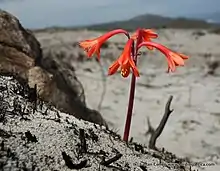Cyrtanthus ventricosus
Cyrtanthus ventricosus, commonly called fire lilly, is a small deciduous, bulbous plant reaching a height of 100–250 mm (3.9–9.8 in). It is in the amaryllis family, Amaryllidaceae, and is found along the Cape Fold Mountains from the Cape Peninsula, Western Cape, to the Kouga Mountains, Eastern Cape in South Africa.[2] [3]
| Cyrtanthus ventricosus | |
|---|---|
 | |
| Scientific classification | |
| Kingdom: | Plantae |
| Clade: | Tracheophytes |
| Clade: | Angiosperms |
| Clade: | Monocots |
| Order: | Asparagales |
| Family: | Amaryllidaceae |
| Subfamily: | Amaryllidoideae |
| Genus: | Cyrtanthus |
| Species: | C. ventricosus |
| Binomial name | |
| Cyrtanthus ventricosus | |
| Synonyms[1] | |
Fire lilly produces beautiful, salmon to scarlet blooms just nine days after fire occurs at the place where the plant stands.
Description
The fire lily produces tubular pink to bright red flowers.[3] Each tepal has a darker strip down the middle.[2] These are borne in an inflorescence containing 1-14 individual flowers.[2][4] Rarely, a plant will produce two inflorescences.[4] Flowers are most common from December to May, but are only produced after fires, stimulated by the smoke.[5] The flat, black seeds have wings and are dispersed by the wind.[2] The bulbs produce linear leaves every winter (June-August).[2] The leaves and flowers are not present at the same time.
Ecology
This plant flowers after wildfires. The red flowers are clearly visible against the blackened background to butterflies and sunbirds, the main pollinators of this species.[2][6] They are attracted by the nectar that the flowers produce.[6] Sunbirds sometimes pierce the base of the tube, resulting in them getting the nectar rewards without transferring the pollen between plants.[2] This species has full self-sterility, meaning self-pollinated flowers do not produce seeds.[4]
Conservation
While this plant may only flower after a fire, it is common in its range and the population is considered to be stable. As such, it is listed as Least Concern by the South African National Biodiversity Institute (SANBI).[7]
References
- "Cyrtanthus ventricosus". Global Biodiversity Information Facility. Retrieved 2 September 2022.
- "Cyrtanthus ventricosus". pza.sanbi.org. PlantZAfrica.com. Retrieved 14 December 2018.
- Manning, John; Goldblatt, Peter (2012). Plants of the Greater Cape Floristic Region : 1: the core Cape flora (PDF). Pretoria: South African National Biodiversity Institute, SANBI. ISBN 978-1-919976-74-7. OCLC 852384288.
- Johnson, S. D.; Butler, H. C.; Robertson, A. W. (2019). Ren, Z.‐X. (ed.). "Breeding systems in Cyrtanthus (Amaryllidaceae): variation in self‐sterility and potential for ovule discounting". Plant Biology. 21 (6): 1008–1015. doi:10.1111/plb.13025. ISSN 1435-8603. PMID 31271495. S2CID 195797684.
- Keeley, Jon E. (1993). "Smoke-induced flowering in the fire-lily Cyrtanthus ventricosus". South African Journal of Botany. 59 (6): 638. doi:10.1016/S0254-6299(16)30681-0.
- Johnson, S. D.; Bond, W. J. (1997-02-21). "Evidence for widespread pollen limitation of fruiting success in Cape wildflowers". Oecologia. 109 (4): 530–534. doi:10.1007/s004420050113. ISSN 0029-8549. PMID 28307336. S2CID 24871794.
- Snijman, D.A.; Victor, J.E. (2004). "Cyrtanthus ventricosus Willd". National Assessment: Red List of South African Plants version 2020.
Further reading
- Bond, W. J.; Keeley, J. E. (1 July 2005). "Fire as a global 'herbivore': the ecology and evolution of flammable ecosystems". Trends in Ecology & Evolution. 20 (7): 387–394. doi:10.1016/j.tree.2005.04.025. ISSN 0169-5347. PMID 16701401.
- McMaster, Rhoda; McMaster, Cameron; Duncan, Graham (1 June 2005). "Out of the ashes". Veld & Flora. pp. 66–69.